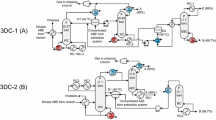Abstract
The solvent deasphalting (SDA) process is a heavy oil upgrading process and used to separate asphaltene, the heaviest and most polar fraction of vacuum residue (VR) of heavy oil, by using density differences, to obtain deasphalted oil (DAO). The SDA process consists of two main stages: asphaltene separation and solvent recovery. Solvent recovery is a key procedure for determining the operating cost of the SDA process, because it uses a considerable amount of costly solvent, the recovery of which consumes huge amounts of energy. In this study, the SDA process was numerically simulated by using three different solvents, propane, n-butane, and isobutane, to examine their effect on the DAO extraction and the effect of the operating temperature and pressure on solvent recovery. The process was designed to contain one extractor, two flash drums, and two steam strippers. The VR was characterized by identifying 15 pseudo-components based on the boiling point distribution, obtained by performing a SIMDIS analysis, and the API gravity of the components. When n-butane was used, the yield of DAO was higher than in the other cases, whereas isobutane showed a similar extraction performance as propane. Solvent recovery was found to increase with temperature and decrease with pressure for all the solvents that were tested and the best results were obtained for propane.
Similar content being viewed by others
References
T. Shi, Y. Hu, Z. Xu, T. Su and R. Wang, Ind. Eng. Chem. Res., 36, 3988 (1997).
M. Ahmaruzzaman and D.K. Sharma, Energy Fuels, 20, 2498 (2006).
S. Shin, J. M. Lee, J.W. Hwang, H.W. Jung, N. S. Nho and K.B. Lee, Chem. Eng. J., 257, 242 (2014).
J.A. Carrillo and L.M. Corredor, Fuel Process. Technol., 109, 156 (2013).
N. Chang and Z. Gu, Korean J. Chem. Eng., 31, 780 (2014).
J.A. Gearhart and L. Garwin, Hydrocarb. Process., 55, 125 (1976).
R.A. Meyers, Handbook of petroleum refining processes, McGraw-Hill, New York (2004).
J.G. Speight, Heavy and extra-heavy oil upgrading technologies, Gulf Professional Publishing, United Kingdom (2013).
H. De Lasa, G. Dogammau and A. Ravella, Chemical reactor technology for environmentally safe reactors and products, Springer, Canada (1992).
R. Iqbal, A. Khan, O. Eng and R. Floyd, PTQ, 13, 31 (2008).
A. Huc, Heavy crude oils: from geology to upgrading: an overview, Editions Technip (2010).
M. N. Dadashev and G.V. Stepanov, Chem. Tech. Fuels Oils, 36, 8 (2000).
M. Subramanian and F.V. Hanson, Fuel Process. Technol., 55, 35 (1998).
P. Luo and Y. Gu, Fluid Phase Equilib., 277, 1 (2009).
J. Ancheyta, G. Centeno, F. Trejo, G. Marroquin, J. Garcia, E. Tenorio and A. Torres, Energy Fuels, 16, 1121 (2002).
F. Trejo, G. Centeno and J. Ancheyta, Fuel, 83, 2169 (2004).
J.M. Lee, S. Shin, S. Ahn, J. H. Chun, K. B. Lee, S. Mun, S. G. Jeon, J. G. Na and N. S. Nho, Fuel Process Technol., 119, 204 (2014).
V.O. C. Cardenas, E.T. Koroishi, F.A.B. Quirino, F.W.R. Rivarola, E.A. Boss, G.W. C. Oliveira, M.R.W. Maciel, R.M. Filho and L. C. Medina, Chem. Eng. Trans., 11, 905 (2007).
L. Wang and J. Gmehling, AIChE J., 45, 1125 (1999).
P. Bahrami, R. Kharrat, S. Mahdavi, Y, Ahmadi and L. James, Korean J. Chem. Eng., 32, 316 (2015).
W.M. Haynes, CRC handbook of chemistry and physics, CRC Press (2012).
F. Cao, D. Jiang, W. Li, P. Du, G. Yang and W. Ying, Chem. Eng. Process., 49, 91 (2010).
D.C. Villalanti, J.C. Raia and J. B. Maynard, High-temperature simulated distillation applications in petroleum characterization, in: R. A. Meyers (Ed.), Encyclopedia of Analytical Chemistry, Wiley, Chichester (2000).
O. C. Mullins, B. Martínez-Haya and A. G. Marshall, Energy Fuels, 22, 1765 (2008).
H. Groenzin and O. C. Mullins, J. Phys. Chem. A, 103, 11237 (1999).
S. Zhao, Z. Xu, C. Xu, K. H. Chung and R. Wang, Fuel, 84, 635 (2005).
S. H. Ng, Energy Fuels, 11, 1127 (1997).
L. C. Kahre, J. Chem. Eng. Data, 18, 267 (1973).
Author information
Authors and Affiliations
Corresponding authors
Rights and permissions
About this article
Cite this article
Ahn, S., Shin, S., Im, S.I. et al. Solvent recovery in solvent deasphalting process for economical vacuum residue upgrading. Korean J. Chem. Eng. 33, 265–270 (2016). https://doi.org/10.1007/s11814-015-0146-3
Received:
Accepted:
Published:
Issue Date:
DOI: https://doi.org/10.1007/s11814-015-0146-3




